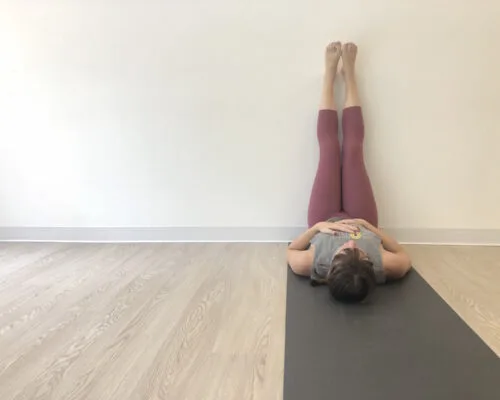Pretty much all yoga is anti-anxiety yoga, especially if you’re practicing regularly over a long period of time.
“Yoga teaches us to manage our reactions by practicing awareness of the body and mind,” says Charlotte Munn, a master trainer at CorePower Yoga, a modern yoga company with studios across the country. “Being aware of the present moment allows you to take more thoughtful pauses during the fluctuating circumstances of daily life. The power in this pause is the power to gain perspective and choose how to respond instead of letting our emotional roller-coaster-reactions dictate the quality of our lives.”
RELATED: A Yoga Teacher’s Morning Trick for Less Stress Throughout the Day
And while you may associate slower, more meditative classes with stress-relief, Munn says depending on your personality, different styles could work. For example, some people find CorePower’s heated, high-intensity Vinyasa classes to be better for anxiety since the vigor takes them out of their “monkey mind” and into their body.” Others don’t find a class relaxing unless they’re in a restorative pose on the floor with a bolster and a blanket.
For the short-term though, when you just need to deal with a wave of anxiety that’s taken over, the best poses are usually pretty slow and focused on mindful breathing “which can have an almost instant result on easing feelings of anxiety,” she says.
Here are a few of her favorites, below. Try one after your next big work presentation…just remember to book that conference room for an extra half hour.
(All Photos: Lisa Held for Nutritious Life)
1. Legs up the wall pose
Legs up the wall can be done with the support of a wall or with a block. If you are practicing against a wall, place your left or right side against the wall. Turn your body to bring your legs straight up the wall. Press your sit bones against the wall so your backside is flush with the wall. Rest your shoulders and head to the floor. If utilizing a block, place the block directly under your sit bones and stack your legs up to the ceiling to float above your hips. In both variations, your legs should feel “weightless” to receive the full benefits of physical and mental decompression. Close your eyes and hold anywhere from two to ten minutes.
2. Constructive rest with draped arms
Lay down on floor and place your feet hip-width distance apart and close enough that you can touch the back of your heels with your fingertips. Simply knock your knees in together so your legs rotate inward. Drape your arms by your side bodies. Soften your eyes and hold anywhere from two to ten minutes.
3. Ragdoll
Bring your feet hip-width distance apart. Fold from your hips so your fingertips graze the floor. Interlace opposite hands to opposite elbows to create a basketlike shape with your arms. Bend your knees and gently sway side to side, forward and back, to release tension in your head and neck. Aim for five to ten breaths.
4. Child’s pose
Kneel on the floor. Bring your big toes to touch and draw your knees out a little wider than your hip bones. Extend your fingertips forward and rest your torso and forehead down to the earth. Allow your gaze to be soft and breathe deeply here for five to ten rounds.
5. Reclined bound angle pose
Lay down on the floor. Bring your feet together to touch so your knees relax out to the right and left sides of your space. Draw your shoulder blades gently inward and let your arms relax by your sides with your palms face up. Option to add blocks underneath your knees for additional support for your low back. Stay here anywhere from one to ten minutes.
6. Equal breathing
Equal breathing can be done in a tall cross-legged seat or laying down. Slowly count to four as you inhale, pause at the top of your exhalation when your lungs are completely full, and then count to four as you exhale. Option to place your hands on your belly and chest to feel your breath travel in and out. Perform anywhere from one to ten minutes.
